Financial Transactions: Accounting Principles and Practices
VerifiedAdded on 2021/02/21
|7
|1798
|63
Homework Assignment
AI Summary
This assignment delves into the core concepts of financial transactions, encompassing a range of accounting principles and practices. It begins by defining financial transactions and their impact on a business's financial position. The solution explores the imprest system for petty cash, contrasting accrual and cash accounting methods, and explaining the rationale behind using accrual accounting. It also clarifies the differences between assets and expenses with examples. The assignment further examines electronic fund transfer processes, methods for tracing deposits, and security measures for handling cash and checks. It covers potential errors in financial transactions and the code of ethics for professional accountants. Additionally, it addresses the purpose and importance of the Tax Agent Service Act 2009, the Fair Work Act 2009, and the Privacy Act 1988. The solution outlines safety measures for cash transport and describes the components of a chart of accounts. Finally, it includes a comprehensive list of references.
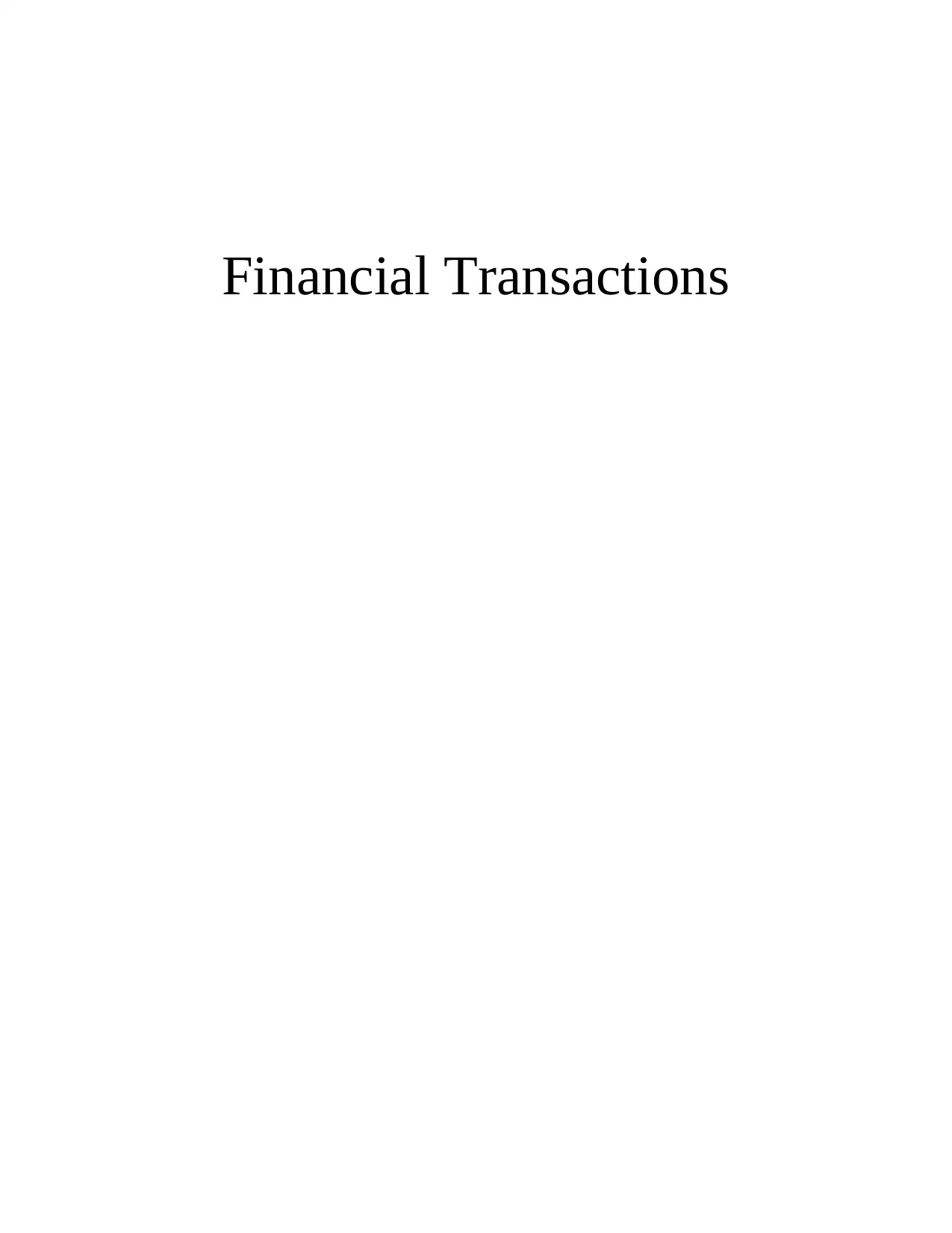
Financial Transactions
Paraphrase This Document
Need a fresh take? Get an instant paraphrase of this document with our AI Paraphraser
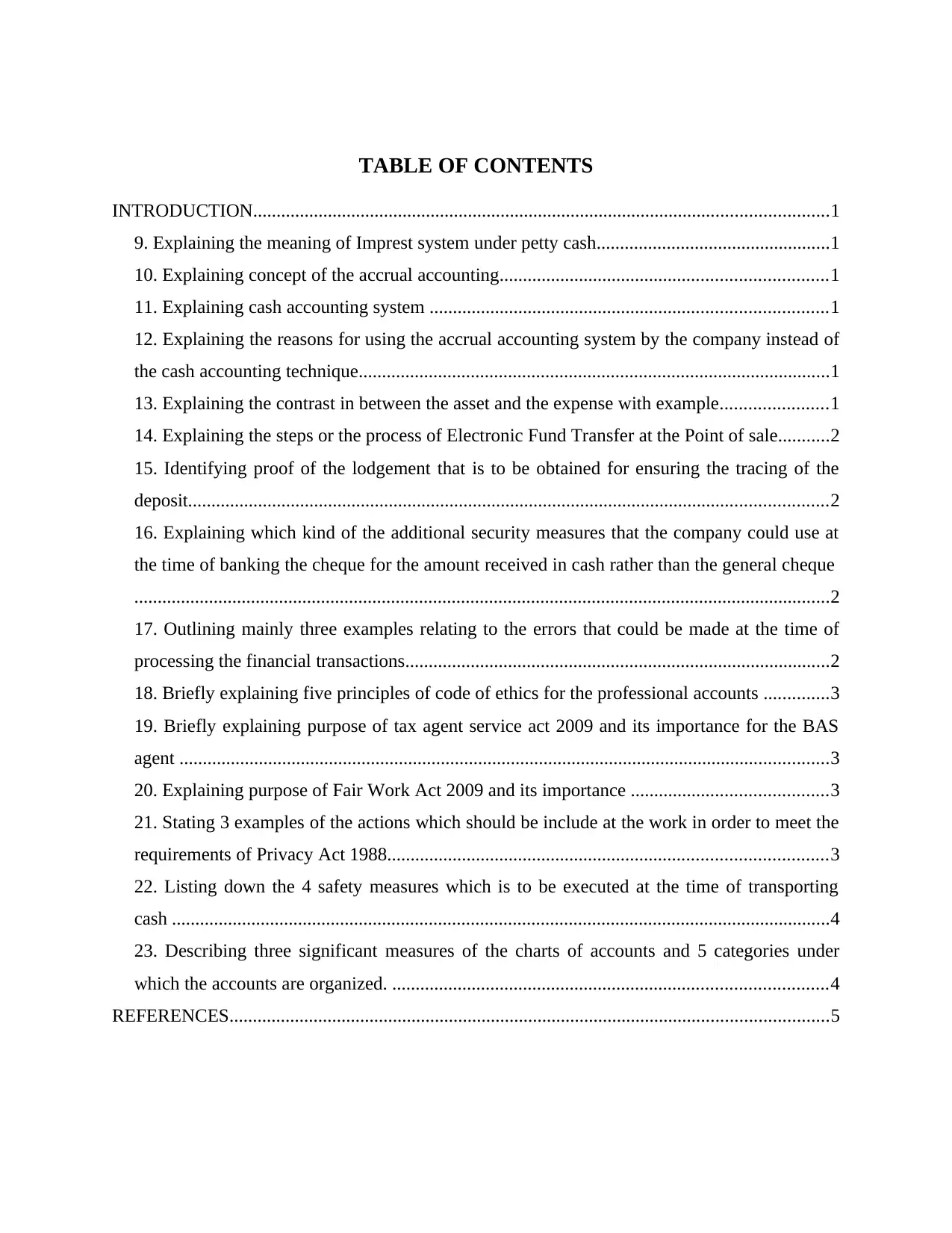
TABLE OF CONTENTS
INTRODUCTION...........................................................................................................................1
9. Explaining the meaning of Imprest system under petty cash..................................................1
10. Explaining concept of the accrual accounting......................................................................1
11. Explaining cash accounting system .....................................................................................1
12. Explaining the reasons for using the accrual accounting system by the company instead of
the cash accounting technique.....................................................................................................1
13. Explaining the contrast in between the asset and the expense with example.......................1
14. Explaining the steps or the process of Electronic Fund Transfer at the Point of sale...........2
15. Identifying proof of the lodgement that is to be obtained for ensuring the tracing of the
deposit.........................................................................................................................................2
16. Explaining which kind of the additional security measures that the company could use at
the time of banking the cheque for the amount received in cash rather than the general cheque
.....................................................................................................................................................2
17. Outlining mainly three examples relating to the errors that could be made at the time of
processing the financial transactions...........................................................................................2
18. Briefly explaining five principles of code of ethics for the professional accounts ..............3
19. Briefly explaining purpose of tax agent service act 2009 and its importance for the BAS
agent ...........................................................................................................................................3
20. Explaining purpose of Fair Work Act 2009 and its importance ..........................................3
21. Stating 3 examples of the actions which should be include at the work in order to meet the
requirements of Privacy Act 1988..............................................................................................3
22. Listing down the 4 safety measures which is to be executed at the time of transporting
cash .............................................................................................................................................4
23. Describing three significant measures of the charts of accounts and 5 categories under
which the accounts are organized. .............................................................................................4
REFERENCES................................................................................................................................5
INTRODUCTION...........................................................................................................................1
9. Explaining the meaning of Imprest system under petty cash..................................................1
10. Explaining concept of the accrual accounting......................................................................1
11. Explaining cash accounting system .....................................................................................1
12. Explaining the reasons for using the accrual accounting system by the company instead of
the cash accounting technique.....................................................................................................1
13. Explaining the contrast in between the asset and the expense with example.......................1
14. Explaining the steps or the process of Electronic Fund Transfer at the Point of sale...........2
15. Identifying proof of the lodgement that is to be obtained for ensuring the tracing of the
deposit.........................................................................................................................................2
16. Explaining which kind of the additional security measures that the company could use at
the time of banking the cheque for the amount received in cash rather than the general cheque
.....................................................................................................................................................2
17. Outlining mainly three examples relating to the errors that could be made at the time of
processing the financial transactions...........................................................................................2
18. Briefly explaining five principles of code of ethics for the professional accounts ..............3
19. Briefly explaining purpose of tax agent service act 2009 and its importance for the BAS
agent ...........................................................................................................................................3
20. Explaining purpose of Fair Work Act 2009 and its importance ..........................................3
21. Stating 3 examples of the actions which should be include at the work in order to meet the
requirements of Privacy Act 1988..............................................................................................3
22. Listing down the 4 safety measures which is to be executed at the time of transporting
cash .............................................................................................................................................4
23. Describing three significant measures of the charts of accounts and 5 categories under
which the accounts are organized. .............................................................................................4
REFERENCES................................................................................................................................5
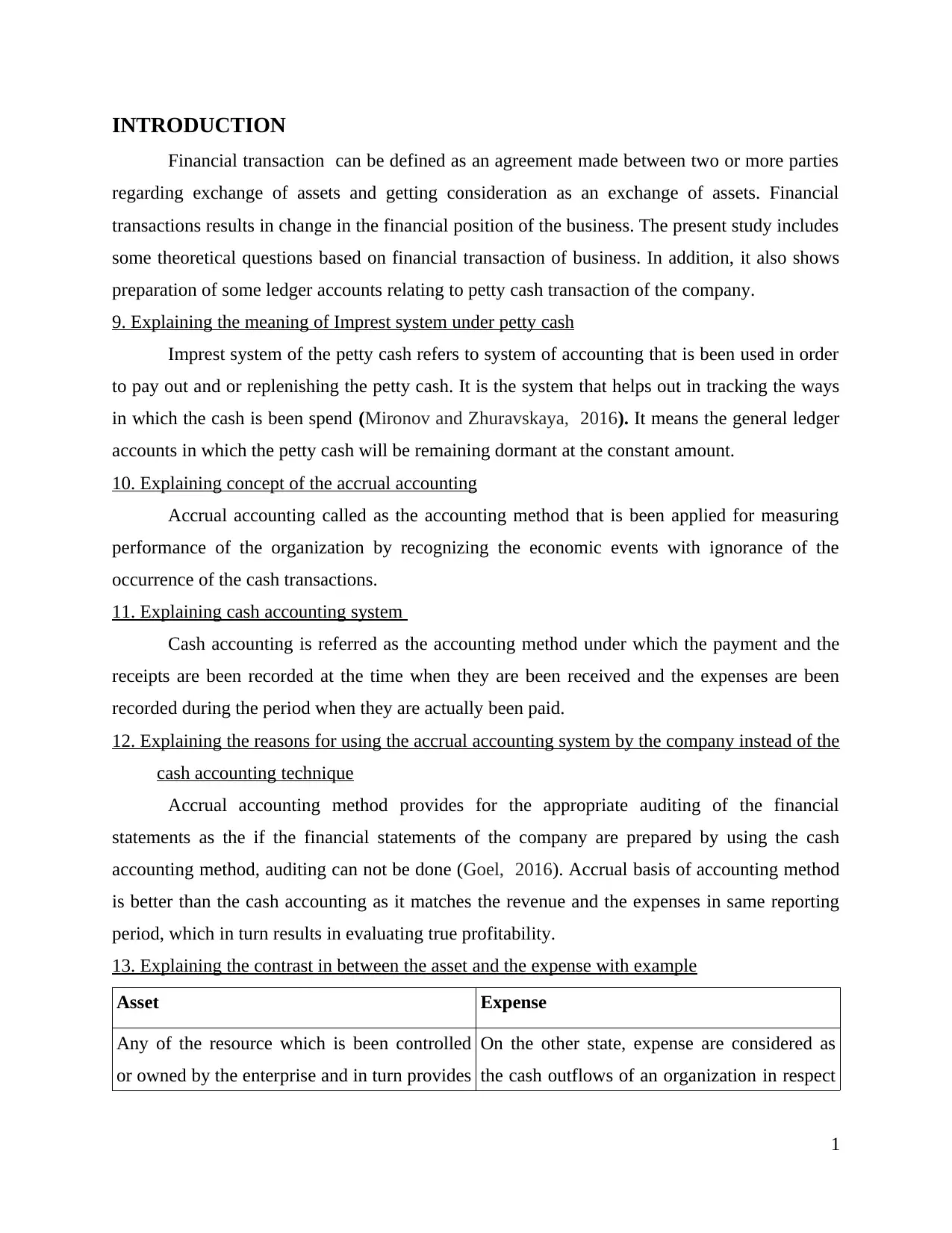
INTRODUCTION
Financial transaction can be defined as an agreement made between two or more parties
regarding exchange of assets and getting consideration as an exchange of assets. Financial
transactions results in change in the financial position of the business. The present study includes
some theoretical questions based on financial transaction of business. In addition, it also shows
preparation of some ledger accounts relating to petty cash transaction of the company.
9. Explaining the meaning of Imprest system under petty cash
Imprest system of the petty cash refers to system of accounting that is been used in order
to pay out and or replenishing the petty cash. It is the system that helps out in tracking the ways
in which the cash is been spend (Mironov and Zhuravskaya, 2016). It means the general ledger
accounts in which the petty cash will be remaining dormant at the constant amount.
10. Explaining concept of the accrual accounting
Accrual accounting called as the accounting method that is been applied for measuring
performance of the organization by recognizing the economic events with ignorance of the
occurrence of the cash transactions.
11. Explaining cash accounting system
Cash accounting is referred as the accounting method under which the payment and the
receipts are been recorded at the time when they are been received and the expenses are been
recorded during the period when they are actually been paid.
12. Explaining the reasons for using the accrual accounting system by the company instead of the
cash accounting technique
Accrual accounting method provides for the appropriate auditing of the financial
statements as the if the financial statements of the company are prepared by using the cash
accounting method, auditing can not be done (Goel, 2016). Accrual basis of accounting method
is better than the cash accounting as it matches the revenue and the expenses in same reporting
period, which in turn results in evaluating true profitability.
13. Explaining the contrast in between the asset and the expense with example
Asset Expense
Any of the resource which is been controlled
or owned by the enterprise and in turn provides
On the other state, expense are considered as
the cash outflows of an organization in respect
1
Financial transaction can be defined as an agreement made between two or more parties
regarding exchange of assets and getting consideration as an exchange of assets. Financial
transactions results in change in the financial position of the business. The present study includes
some theoretical questions based on financial transaction of business. In addition, it also shows
preparation of some ledger accounts relating to petty cash transaction of the company.
9. Explaining the meaning of Imprest system under petty cash
Imprest system of the petty cash refers to system of accounting that is been used in order
to pay out and or replenishing the petty cash. It is the system that helps out in tracking the ways
in which the cash is been spend (Mironov and Zhuravskaya, 2016). It means the general ledger
accounts in which the petty cash will be remaining dormant at the constant amount.
10. Explaining concept of the accrual accounting
Accrual accounting called as the accounting method that is been applied for measuring
performance of the organization by recognizing the economic events with ignorance of the
occurrence of the cash transactions.
11. Explaining cash accounting system
Cash accounting is referred as the accounting method under which the payment and the
receipts are been recorded at the time when they are been received and the expenses are been
recorded during the period when they are actually been paid.
12. Explaining the reasons for using the accrual accounting system by the company instead of the
cash accounting technique
Accrual accounting method provides for the appropriate auditing of the financial
statements as the if the financial statements of the company are prepared by using the cash
accounting method, auditing can not be done (Goel, 2016). Accrual basis of accounting method
is better than the cash accounting as it matches the revenue and the expenses in same reporting
period, which in turn results in evaluating true profitability.
13. Explaining the contrast in between the asset and the expense with example
Asset Expense
Any of the resource which is been controlled
or owned by the enterprise and in turn provides
On the other state, expense are considered as
the cash outflows of an organization in respect
1
⊘ This is a preview!⊘
Do you want full access?
Subscribe today to unlock all pages.

Trusted by 1+ million students worldwide
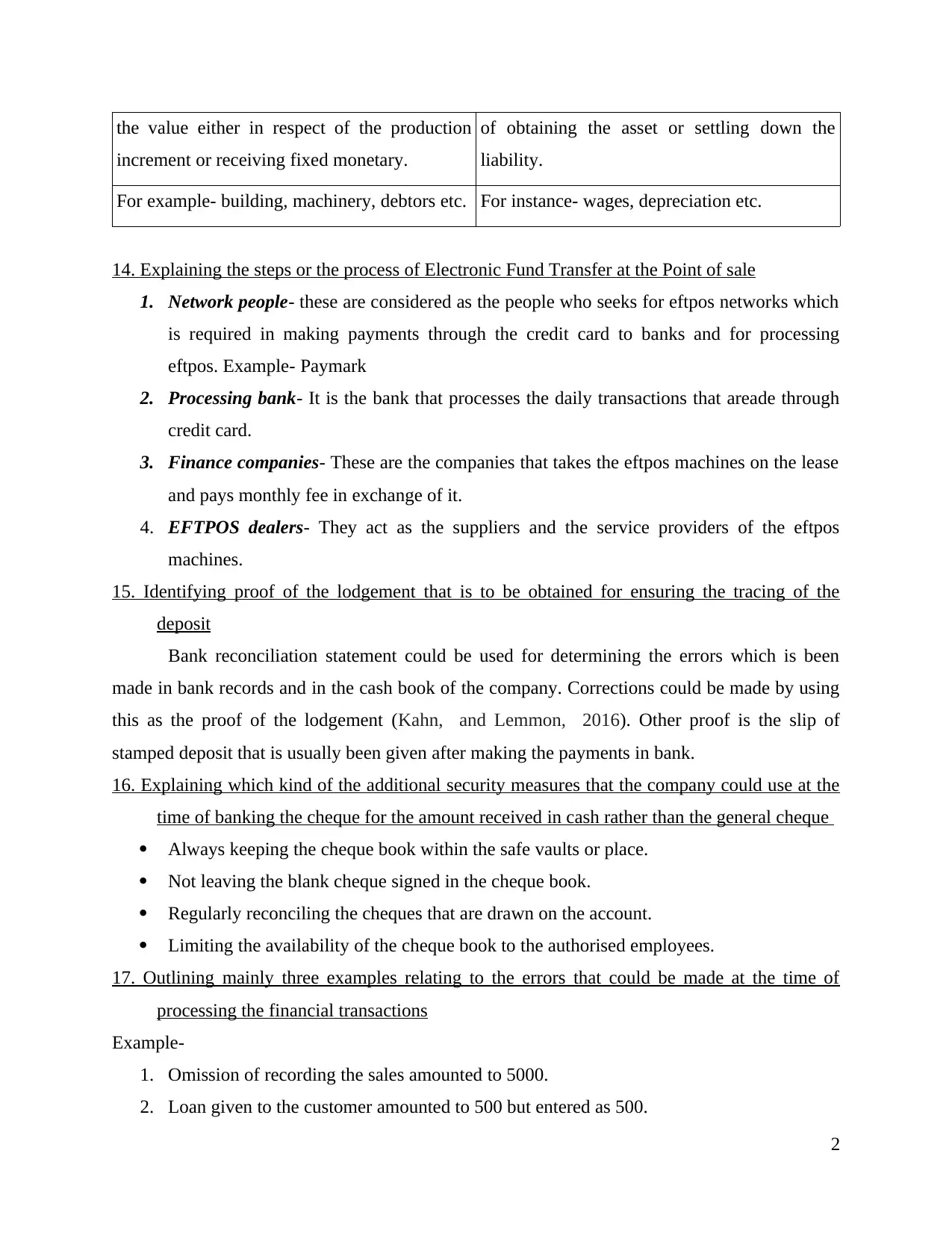
the value either in respect of the production
increment or receiving fixed monetary.
of obtaining the asset or settling down the
liability.
For example- building, machinery, debtors etc. For instance- wages, depreciation etc.
14. Explaining the steps or the process of Electronic Fund Transfer at the Point of sale
1. Network people- these are considered as the people who seeks for eftpos networks which
is required in making payments through the credit card to banks and for processing
eftpos. Example- Paymark
2. Processing bank- It is the bank that processes the daily transactions that areade through
credit card.
3. Finance companies- These are the companies that takes the eftpos machines on the lease
and pays monthly fee in exchange of it.
4. EFTPOS dealers- They act as the suppliers and the service providers of the eftpos
machines.
15. Identifying proof of the lodgement that is to be obtained for ensuring the tracing of the
deposit
Bank reconciliation statement could be used for determining the errors which is been
made in bank records and in the cash book of the company. Corrections could be made by using
this as the proof of the lodgement (Kahn, and Lemmon, 2016). Other proof is the slip of
stamped deposit that is usually been given after making the payments in bank.
16. Explaining which kind of the additional security measures that the company could use at the
time of banking the cheque for the amount received in cash rather than the general cheque
Always keeping the cheque book within the safe vaults or place.
Not leaving the blank cheque signed in the cheque book.
Regularly reconciling the cheques that are drawn on the account.
Limiting the availability of the cheque book to the authorised employees.
17. Outlining mainly three examples relating to the errors that could be made at the time of
processing the financial transactions
Example-
1. Omission of recording the sales amounted to 5000.
2. Loan given to the customer amounted to 500 but entered as 500.
2
increment or receiving fixed monetary.
of obtaining the asset or settling down the
liability.
For example- building, machinery, debtors etc. For instance- wages, depreciation etc.
14. Explaining the steps or the process of Electronic Fund Transfer at the Point of sale
1. Network people- these are considered as the people who seeks for eftpos networks which
is required in making payments through the credit card to banks and for processing
eftpos. Example- Paymark
2. Processing bank- It is the bank that processes the daily transactions that areade through
credit card.
3. Finance companies- These are the companies that takes the eftpos machines on the lease
and pays monthly fee in exchange of it.
4. EFTPOS dealers- They act as the suppliers and the service providers of the eftpos
machines.
15. Identifying proof of the lodgement that is to be obtained for ensuring the tracing of the
deposit
Bank reconciliation statement could be used for determining the errors which is been
made in bank records and in the cash book of the company. Corrections could be made by using
this as the proof of the lodgement (Kahn, and Lemmon, 2016). Other proof is the slip of
stamped deposit that is usually been given after making the payments in bank.
16. Explaining which kind of the additional security measures that the company could use at the
time of banking the cheque for the amount received in cash rather than the general cheque
Always keeping the cheque book within the safe vaults or place.
Not leaving the blank cheque signed in the cheque book.
Regularly reconciling the cheques that are drawn on the account.
Limiting the availability of the cheque book to the authorised employees.
17. Outlining mainly three examples relating to the errors that could be made at the time of
processing the financial transactions
Example-
1. Omission of recording the sales amounted to 5000.
2. Loan given to the customer amounted to 500 but entered as 500.
2
Paraphrase This Document
Need a fresh take? Get an instant paraphrase of this document with our AI Paraphraser
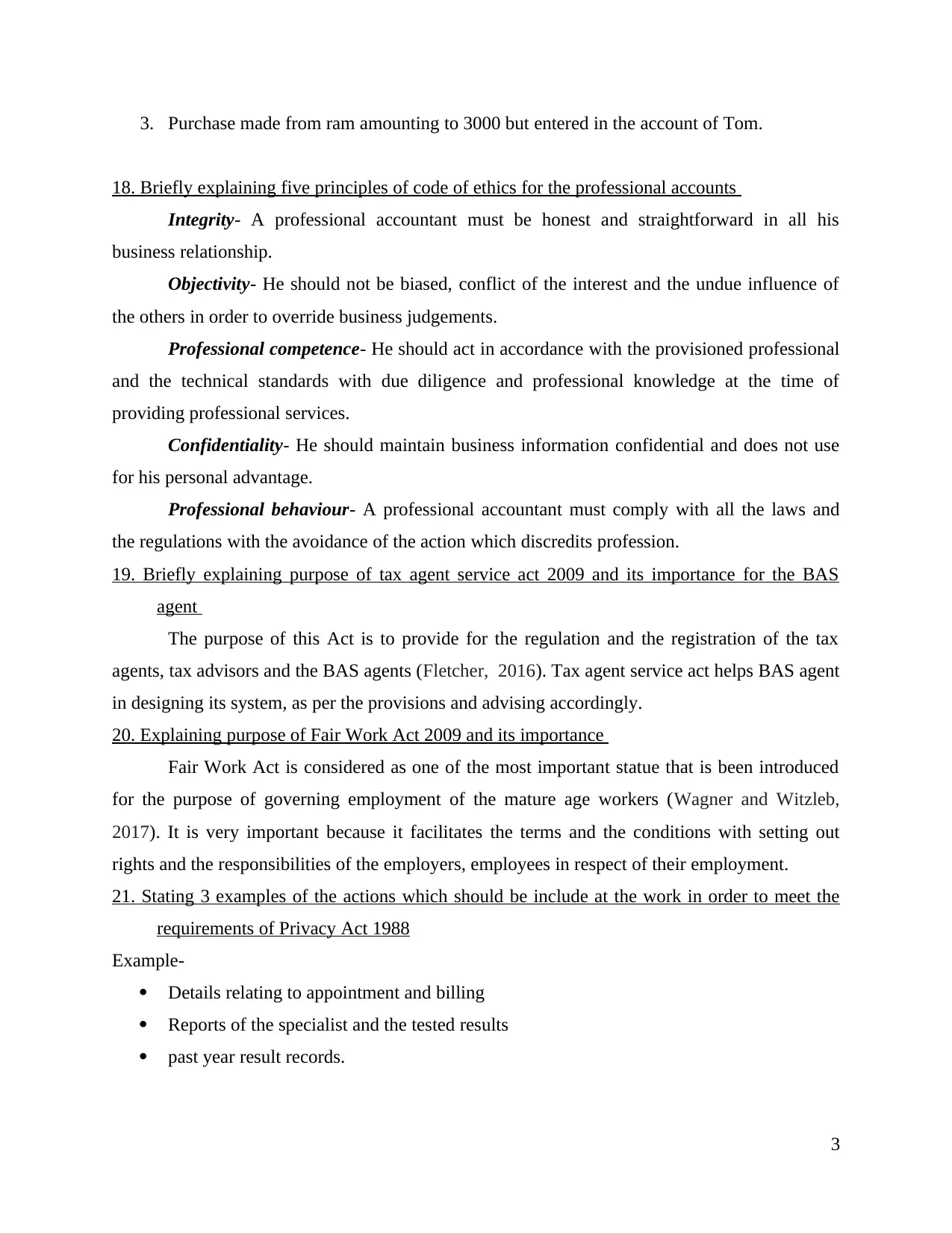
3. Purchase made from ram amounting to 3000 but entered in the account of Tom.
18. Briefly explaining five principles of code of ethics for the professional accounts
Integrity- A professional accountant must be honest and straightforward in all his
business relationship.
Objectivity- He should not be biased, conflict of the interest and the undue influence of
the others in order to override business judgements.
Professional competence- He should act in accordance with the provisioned professional
and the technical standards with due diligence and professional knowledge at the time of
providing professional services.
Confidentiality- He should maintain business information confidential and does not use
for his personal advantage.
Professional behaviour- A professional accountant must comply with all the laws and
the regulations with the avoidance of the action which discredits profession.
19. Briefly explaining purpose of tax agent service act 2009 and its importance for the BAS
agent
The purpose of this Act is to provide for the regulation and the registration of the tax
agents, tax advisors and the BAS agents (Fletcher, 2016). Tax agent service act helps BAS agent
in designing its system, as per the provisions and advising accordingly.
20. Explaining purpose of Fair Work Act 2009 and its importance
Fair Work Act is considered as one of the most important statue that is been introduced
for the purpose of governing employment of the mature age workers (Wagner and Witzleb,
2017). It is very important because it facilitates the terms and the conditions with setting out
rights and the responsibilities of the employers, employees in respect of their employment.
21. Stating 3 examples of the actions which should be include at the work in order to meet the
requirements of Privacy Act 1988
Example-
Details relating to appointment and billing
Reports of the specialist and the tested results
past year result records.
3
18. Briefly explaining five principles of code of ethics for the professional accounts
Integrity- A professional accountant must be honest and straightforward in all his
business relationship.
Objectivity- He should not be biased, conflict of the interest and the undue influence of
the others in order to override business judgements.
Professional competence- He should act in accordance with the provisioned professional
and the technical standards with due diligence and professional knowledge at the time of
providing professional services.
Confidentiality- He should maintain business information confidential and does not use
for his personal advantage.
Professional behaviour- A professional accountant must comply with all the laws and
the regulations with the avoidance of the action which discredits profession.
19. Briefly explaining purpose of tax agent service act 2009 and its importance for the BAS
agent
The purpose of this Act is to provide for the regulation and the registration of the tax
agents, tax advisors and the BAS agents (Fletcher, 2016). Tax agent service act helps BAS agent
in designing its system, as per the provisions and advising accordingly.
20. Explaining purpose of Fair Work Act 2009 and its importance
Fair Work Act is considered as one of the most important statue that is been introduced
for the purpose of governing employment of the mature age workers (Wagner and Witzleb,
2017). It is very important because it facilitates the terms and the conditions with setting out
rights and the responsibilities of the employers, employees in respect of their employment.
21. Stating 3 examples of the actions which should be include at the work in order to meet the
requirements of Privacy Act 1988
Example-
Details relating to appointment and billing
Reports of the specialist and the tested results
past year result records.
3
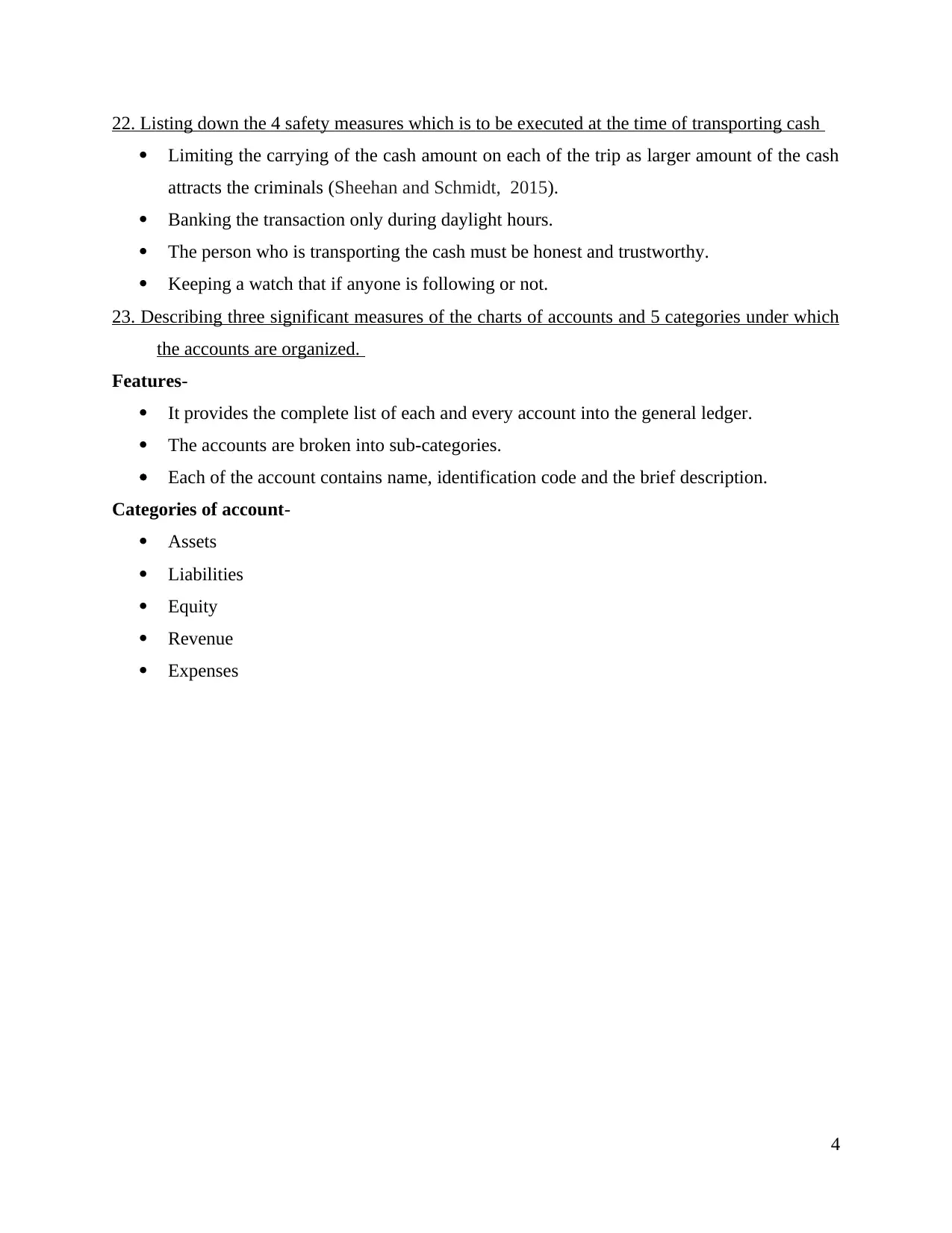
22. Listing down the 4 safety measures which is to be executed at the time of transporting cash
Limiting the carrying of the cash amount on each of the trip as larger amount of the cash
attracts the criminals (Sheehan and Schmidt, 2015).
Banking the transaction only during daylight hours.
The person who is transporting the cash must be honest and trustworthy.
Keeping a watch that if anyone is following or not.
23. Describing three significant measures of the charts of accounts and 5 categories under which
the accounts are organized.
Features-
It provides the complete list of each and every account into the general ledger.
The accounts are broken into sub-categories.
Each of the account contains name, identification code and the brief description.
Categories of account-
Assets
Liabilities
Equity
Revenue
Expenses
4
Limiting the carrying of the cash amount on each of the trip as larger amount of the cash
attracts the criminals (Sheehan and Schmidt, 2015).
Banking the transaction only during daylight hours.
The person who is transporting the cash must be honest and trustworthy.
Keeping a watch that if anyone is following or not.
23. Describing three significant measures of the charts of accounts and 5 categories under which
the accounts are organized.
Features-
It provides the complete list of each and every account into the general ledger.
The accounts are broken into sub-categories.
Each of the account contains name, identification code and the brief description.
Categories of account-
Assets
Liabilities
Equity
Revenue
Expenses
4
⊘ This is a preview!⊘
Do you want full access?
Subscribe today to unlock all pages.

Trusted by 1+ million students worldwide
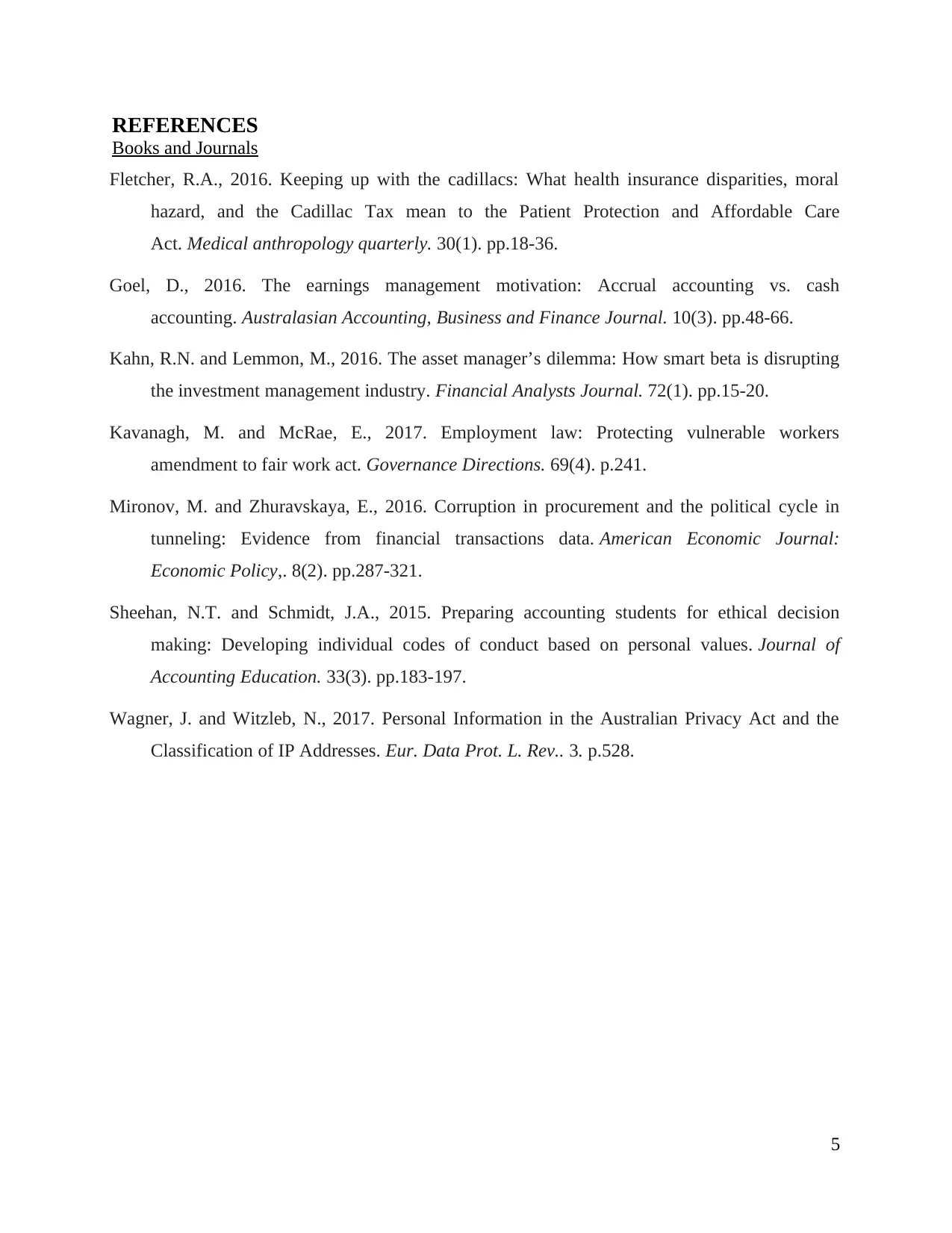
REFERENCES
Books and Journals
Fletcher, R.A., 2016. Keeping up with the cadillacs: What health insurance disparities, moral
hazard, and the Cadillac Tax mean to the Patient Protection and Affordable Care
Act. Medical anthropology quarterly. 30(1). pp.18-36.
Goel, D., 2016. The earnings management motivation: Accrual accounting vs. cash
accounting. Australasian Accounting, Business and Finance Journal. 10(3). pp.48-66.
Kahn, R.N. and Lemmon, M., 2016. The asset manager’s dilemma: How smart beta is disrupting
the investment management industry. Financial Analysts Journal. 72(1). pp.15-20.
Kavanagh, M. and McRae, E., 2017. Employment law: Protecting vulnerable workers
amendment to fair work act. Governance Directions. 69(4). p.241.
Mironov, M. and Zhuravskaya, E., 2016. Corruption in procurement and the political cycle in
tunneling: Evidence from financial transactions data. American Economic Journal:
Economic Policy,. 8(2). pp.287-321.
Sheehan, N.T. and Schmidt, J.A., 2015. Preparing accounting students for ethical decision
making: Developing individual codes of conduct based on personal values. Journal of
Accounting Education. 33(3). pp.183-197.
Wagner, J. and Witzleb, N., 2017. Personal Information in the Australian Privacy Act and the
Classification of IP Addresses. Eur. Data Prot. L. Rev.. 3. p.528.
5
Books and Journals
Fletcher, R.A., 2016. Keeping up with the cadillacs: What health insurance disparities, moral
hazard, and the Cadillac Tax mean to the Patient Protection and Affordable Care
Act. Medical anthropology quarterly. 30(1). pp.18-36.
Goel, D., 2016. The earnings management motivation: Accrual accounting vs. cash
accounting. Australasian Accounting, Business and Finance Journal. 10(3). pp.48-66.
Kahn, R.N. and Lemmon, M., 2016. The asset manager’s dilemma: How smart beta is disrupting
the investment management industry. Financial Analysts Journal. 72(1). pp.15-20.
Kavanagh, M. and McRae, E., 2017. Employment law: Protecting vulnerable workers
amendment to fair work act. Governance Directions. 69(4). p.241.
Mironov, M. and Zhuravskaya, E., 2016. Corruption in procurement and the political cycle in
tunneling: Evidence from financial transactions data. American Economic Journal:
Economic Policy,. 8(2). pp.287-321.
Sheehan, N.T. and Schmidt, J.A., 2015. Preparing accounting students for ethical decision
making: Developing individual codes of conduct based on personal values. Journal of
Accounting Education. 33(3). pp.183-197.
Wagner, J. and Witzleb, N., 2017. Personal Information in the Australian Privacy Act and the
Classification of IP Addresses. Eur. Data Prot. L. Rev.. 3. p.528.
5
1 out of 7
Related Documents
Your All-in-One AI-Powered Toolkit for Academic Success.
+13062052269
info@desklib.com
Available 24*7 on WhatsApp / Email
![[object Object]](/_next/static/media/star-bottom.7253800d.svg)
Unlock your academic potential
Copyright © 2020–2025 A2Z Services. All Rights Reserved. Developed and managed by ZUCOL.




